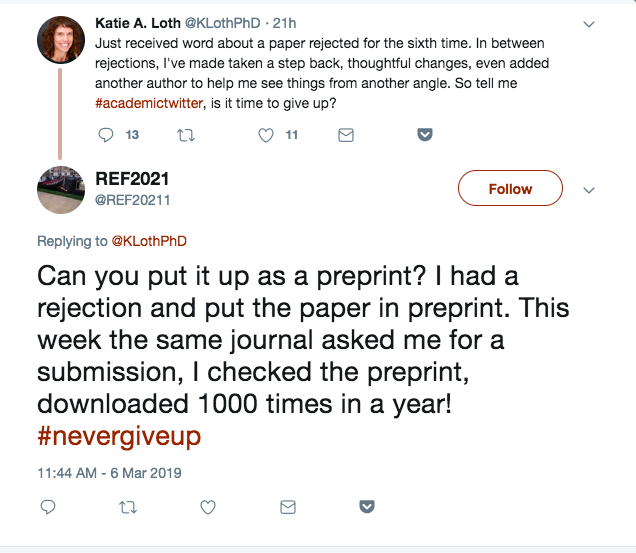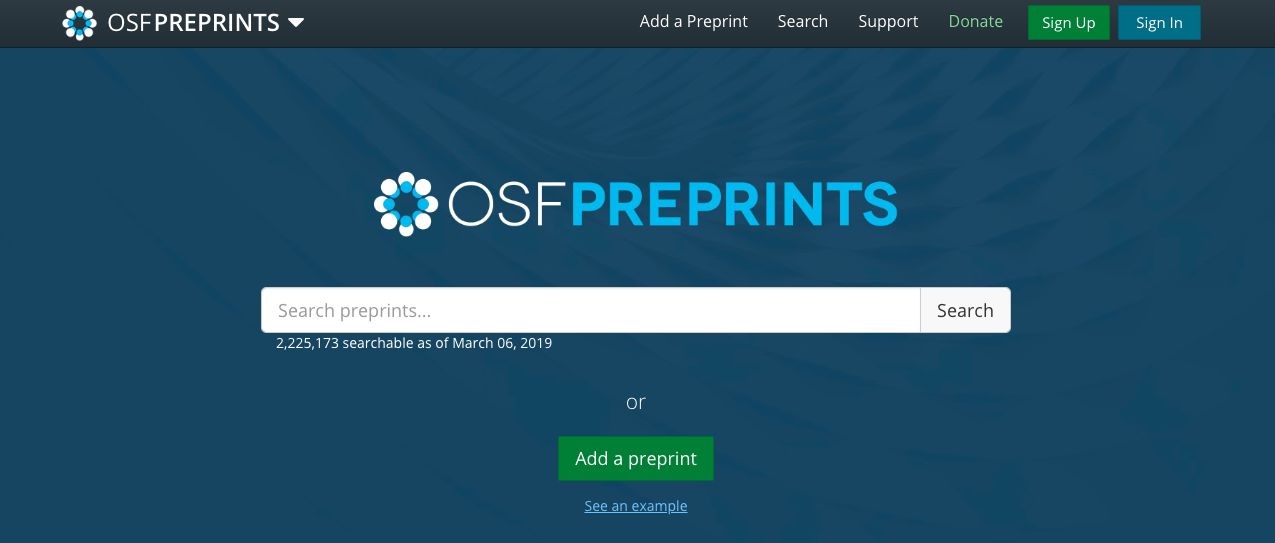← Go Back to the Impact Challenge Table of Contents

Scicom1 © Rob Loftis. Licensed CC-BY
Posting preprints has been popular in disciplines like physics for a while, and it has caught on in many other fields too. It’s easy to see why: publishing preprints gets your work out right away, while still letting you publish the formally peer-reviewed version later. That has some big advantages:
- You establish intellectual precedence for your ideas
- It makes your scholarship available to the broadest possible audience
- It helps research in your field move more quickly
- You can get early feedback from colleagues
- You can start accumulating citations right away
In this week’s challenge, we’ll correct some common misconceptions about sharing preprints and discuss your options for where to post them. Let’s get down to it!
Fact vs. Fiction
Fact: Posting preprints makes your scholarship freely available to all
You can get the “prestige” of publishing with traditional toll-access journals while still posting your work in places where the public and other scholars can access it. That access means that others can cite your work before it’s been formally published, getting you more citations. More importantly, that access fulfills your duty as a scholar: to advance knowledge for all.
Fiction: You’ll get scooped
Some worry that if their results are online before publication, others will be able to scoop them by publishing a similar study. Yet, researchers share their work all the time at conferences without similar worries, and in fact having a digital footprint that proves you’ve established intellectual precedence can actually prevent scooping. As paleontologist Mike Taylor points out,
Fact: Receive feedback on your work, before you submit it
If you’re posting your work to a disciplinary preprint server where your colleagues are likely to read it, you can benefit from your community’s constructive feedback ahead of submitting your article for publication. And even if your work is already in press, you can get feedback on your soon-to-be-published work immediately, rather than months (or years) later when the paper is finally published exemplified by this account from Erin McKiernan,
Fact: Preprints aren’t rigorously peer reviewed
Last year I posted a preprint.
Doing this set off a chain of events that convinced me I should post a preprint for ALL my manuscripts.
Here’s my story (1/17)— Dan Quintana (@dsquintana) February 10, 2018
Fact: Preprints can advance science much more rapidly than traditional publishing
By posting your preprints, others can more quickly build upon your work, accelerating research and discovery. After all, it can take years for papers to be published after their acceptance. And that can lead to situations like Mike Taylor’s:
Preprints will help you circumvent publication delays that would prevent your colleagues from reading your work – potentially years-long delays!
Fact: Preprints can accumulate citations prior to formal publication

A major advantage to preprints is the speed with which they can accumulate citations. Scientists report getting citations for preprints in articles that are published before their articles are, and citing others ahead of their article’s formal publication. Would you prefer that others didn’t cite your preprint, and waited for the final copy? That’s as easy as adding a warning to the header of your article (as we see here and here).
“Wait. Shouldn’t only peer-reviewed work be included in a reference list?“ Increasingly the answer is, “No. Not exclusively.”
Fiction: Journals won’t publish your work if it’s already been posted online
It’s a common misconception that if you post your preprints online before they’ve been published, most journals won’t allow you to publish it formally, citing “prior publication.” As ecologist Ethan White points out,
And some publishers (PLOS, PeerJ, and eLife, among others) even encourage the posting of preprints! You can check this list of preprint policies or Sherpa/Romeo to find out what the policies are for your journal of choice. If you’re still unsure, contact your liaison librarian or your journal’s editors for more information.
Where to post preprints
Options abound for posting your preprints. Note that some of the following options are considered commercial repositories, and thus might not be eligible for use under some publishers’ conditions.
Figshare
Figshare is a popular, discipline-agnostic, commercial repository that’s free to use and has a CLOCKSS-backed preservation strategy. Figshare issues DOIs for the content it hosts, offers altmetrics (views and shares) to help you track the readership and interest in your preprint, and requires CC-BY licenses for publicly accessible preprints. Figshare’s commenting feature allows for easy, public feedback on your work.
One downside to Figshare is that it’s easy for your preprint to get lost in the mix among all the other data, posters, and other scholarly outputs that are shared on the site, from many different disciplines. It’s also a for-profit venture, meaning it wouldn’t meet the non-commercial requirement that some journals have for preprints.
PeerJ PrePrints
PeerJ PrePrints is a preprint server for the biomedical sciences that’s closely integrated with the Open Access journal, PeerJ. PeerJ PrePrints is free to use and popular in the Open Science community due to its sleek submission interface and the availability of altmetrics. PeerJ PrePrints also offers a commenting feature for feedback.
Like Figshare, PeerJ PrePrints will not meet the “non-commercial” requirement for sharing preprints that some journals may have.
arXiv
arXiv is one of the oldest and most famous preprint servers, and it serves mostly the physics, maths, and computational science communities. It’s a non-profit venture run by Cornell University Library, meaning it meets the “non-commercial” requirement of some publishers. By virtue of being a disciplinary repository, it’s a good place to post your work so that others in your field will read it.
Two drawbacks of ArXiv are that it’s not often used by those outside of physics and its other core disciplines, and that it doesn’t offer altmetrics, making it impossible to know the extent to which your work has been viewed and downloaded on the platform. Though potentially frustrating for authors, ArXiv makes a philosophical argument that collecting and displaying download statistics is not as useful of a practice as it might appear to be.
bioRxiv
bioRxiv is popular with researchers in the life sciences (biology in particular, as you might have guessed) and operates in a manner similar to arXiv (non-profit, stewarded by Cold Springs Harbor Laboratory, and discipline-oriented). Authors can upload their preprints, which are assigned a DOI. Users can give feedback on preprints via the simple-to-use commenting function (a good example of which can be found here).
OSF Preprints

The Open Science Framework is a scholarly commons that aims to close the loop on the entire research cycle. Their service, OSF Preprints, is a platform that preprint services can use as the infrastructure to support their communities. As such, it is a good place to begin searching for preprints as it acts as a syndicate of all the archive services based upon it.
Disciplinary Preprint Services
With academics’ increased attention on the shortcomings of the academic publishing system, along with the demonstrated success of preprints servers like arXiv, the number of disciplinary preprint servers has grown tremendously in the past several years. And it is continuing to grow! This is a non-exhaustive list of preprint servers organized by discipline. Some of these host work outside the stated discipline categories where boundaries between subjects are blended. Even though the practice of publishing preprints started in the sciences, it is quickly gaining popularity in other fields. Scholars in law, humanities, and the social sciences are having success with posting their preprints.
Engineering
- engrXiv – open archive of engineering
- FocUS Archive – focused ultrasound research community
Humanities
- Humanities Commons – a network for people working in the Humanities
- MLA Commons – a network for MLA members
- LingBuzz – archive and community space for Linguistics
- SocArXiv – open archive of the social sciences
- Cogprints – archive for the areas of Psychology, Neuroscience, Linguistics, and Computer Science
Law
- LawArXiv – archive for the legal community
Life Sciences
- bioRxiv – a preprint server for Biology
- PaleorXiv – a preprint archive for Paleontology
- AgriXiv – a preprint archive for Agriculture and Allied Sciences
- MarXiv – a free research repository for the ocean and marine-climate sciences
- EcoEvoRxiv – a preprint service for Ecology, Evolution, and Conservation
- PeerJ Preprints – a preprint service for the biological, medical, and environmental sciences
Medicine
- SportRxiv – open access subject repository for sport, exercise, performance, and health research
- NutriXiv – a preprint service for the nutritional sciences
- FocUS Archive – focused ultrasound research community
- PsyArXiv – a preprint service for the psychological sciences
- MindRxiv – open archive for research on mind and contemplative practices
- Therapoid – community enabling collaboration among life science researchers
Physical Sciences
- ChemRxiv – a preprint server for Chemistry
- EarthArXiv – a preprint service for the Earth sciences
- ECSarXiv – a preprint service for Electrochemistry and solid state science and technology
Social and Behavioral Sciences

- SocArXiv – open archive of the social sciences
- PsyArXiv – a preprint service for the psychological sciences
- BITSS – an interdisciplinary archive maintained by the Berkeley Initiative for Transparency in the Social Sciences
- LIS Scholarship Archive – open scholarly platform for Library and Information Science
- MediArXiv – open archive for Media, Film, and Communication Studies
- MindRxiv – open archive for research on mind and contemplative practices
- Cogprints – archive for the areas of Psychology, Neuroscience, Linguistics, and Computer ScienceRePEc – a collaborative effort to enhance and disseminate research in Economics and related sciences
- RePEc – a collaborative effort to enhance and disseminate research in Economics and related sciences
Homework
For this week’s homework, you’re going to do some due diligence. Use this list of preprint policies and Sherpa/Romeo to learn what journals in your discipline allow pre-publication archiving, and do some thinking on how you can share your next manuscript prior to publication. That way, when you’re writing your next one you’ve got a preprint server in mind for it, so you can share it as quickly as possible. Remember – the more content you’ve got online and freely available, the more everyone benefits (including you).
Content for the OU Impact Challenge has been derived from “The 30-Day Impact Challenge” by Stacy Konkiel © ImpactStory and used here under a CC BY 4.0 International License.
The OU Impact Challenge is licensed CC BY 4.0, unless otherwise noted.